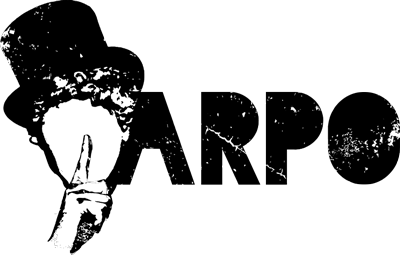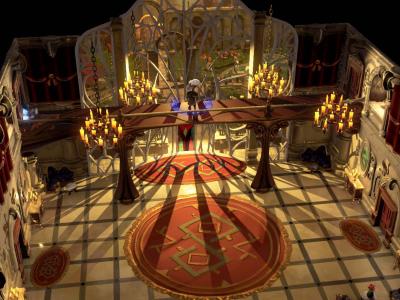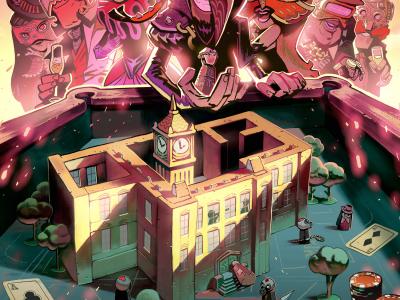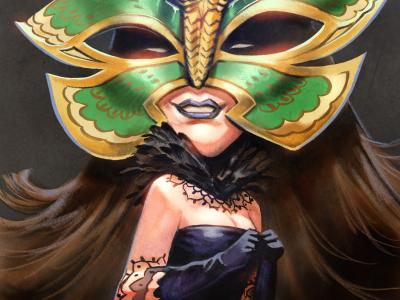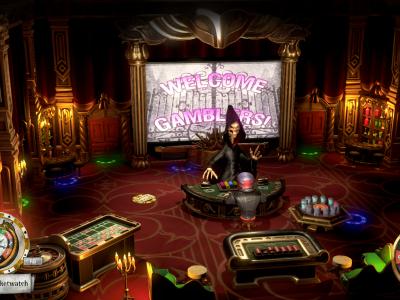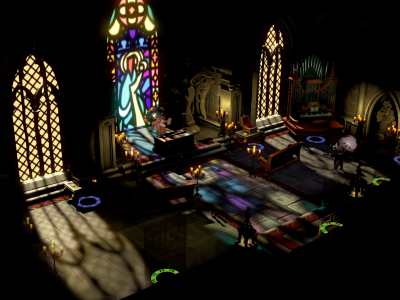Son qui a dilettarmi della qualunque, tra un Giorno della Marmotta e l'altro, quando il giorno, infame, ricomicia.
Sono all'insolita festa, la villa è barocca e damascata e soffocante di rivoli d'ombre e musiche esotiche. La festa è in maschera e i morti abbondano.
Qualcuno m'infila a viva forza una maschera e un orologio tutto rotto e m'impone di ricominciare d'accapo. Ancora, e ancora, e ancora.
O almeno finché non risolvo la situazione ed evito il mortifero guaio: evitando tutti gli omicidi a venire.
Questa, malamente, è la sostanza di The Sexy Brutale, gioco d'insospettabile bellezza che vive qualche complicazione strettamente tecnica.
Eppure, l'estetica affascinante, scura e morbosa, unita all'intreccio da Ten Little Niggers, finisce per piacere più di quanto sia lecito attendersi. E rimanere in testa.
Ne ho parlato con James Griffiths, narrative director del gioco.
Central to the concept of the game is the temporal loop: this has shaped the narrative side of the game? Also, you were after this kind of interactive fiction or do you consider a priority creating an entertaining gameplay?
The temporal loop was the starting point. All three of us loved other “schedule-based” games, especially Majora’s Mask and Gregory Horror Show, so we wanted to see if there was something we could do in that space. It also had the clear advantage of meaning that by using time as a dimensional to explore, we could create a more dense experience even without having an enormous map. One room could be made so much more deep an interesting if visiting it multiple times over a 9 minute period showed different things each time. The narrative then was built how I/we believe all narratives in games should be built – to serve, support and enhance the design of the game experience. Gameplay is king, always. Once we knew the game was going to be a looping time experience, that challenge for the story was figuring out what possible explanation there could be for that. What would allow us to have cool murders, an interesting cast of characters, and something that explain the fact that time loops?
It was an agonizing process – but we’re very proud of how well the narrative and design work together to create something that we feel is unique and meaningful.
Which, among all the works of fiction, are the ones that have inspired you the most in the developing of the game?
Groundhog Day was absolutely one of the references, but not as big an influence as people might think. The real value of Groundhog Day for us, was that it could be used as a kind of shorthand to explain what the game actually was. People know what Groundhog Day is – and that was really useful. Groundhog Day is all about exploring the near-infinite, cascading choices a person would have during a single day. The Sexy Brutale focuses on finding the SINGLE action that will really make a difference in a day, with a very specific goal.
The other really big influences were:
Gregory Horror Show – an amazing and much overlooked (but flawed) PS2 game where you are creeping around a haunted hotel trying to steal the souls of the other guests.
The Masque of the Red Death/Punchdrunk Plays – these are theatre productions that we all loved, where the audience are released into an abandoned building with little to no guidance. By wandering around you will see the actors doing things simultaneously all over the building. You can’t ever see everything on your own, so the best thing is to go with a group of friends, split up and then compare notes at the end. The plays are amazing experiences.
The main difference with the other examples given here is that we had to focus very clearly on a finite number of possibilities. The Sexy Brutale was never and COULD never be a game where you can try multiple things and have multiple reactions. It was about everything being 99% the same every day – and you have to find the ONE THING that you can do to bring about a change. It was a very tight focus, to make sure that we weren’t creating something that would simply spiral out of any control.
The core concept of your game is quite appropriate for the video game medium itself: to try, progress and exit the “loop” is a basic mechanic. Did you think about those aspects, loading the game with meta-commentary, or was it just something you found to be entertaining and challenging? What about the work of single “auteurs” that insist on meta-commentary, changing gameplay mechanics and reflecting on the medium?
The challenge I think was not so much loading the game with commentary ON the game mechanics, but rather looking for the best way to make the mechanics tie in as closely to the narrative and experience as possible.
Games are meant to be games. There are certain things that are just woven into the very nature of most games – restarting, gaining knowledge, exploring and so on – and what we wanted to do was try to bring those aspects into an acknowledged part of the game. The day doesn’t run out and restart “just because” – there’s a reason behind it, and it’s internally consistent. I totally don’t believe that all games need to do that – but it was a battle that we picked because we thought it was achievable, and would help create a real sense of identity and coherence for the game.
My brother is an enormous fan of Jonathan Blow, who is an extra-ordinary game maker. I’ve also always loved the Metal Gear series. I think a lot of the “meta” aspects in those games are, fundamentally, gimmicks – but I actually don’t mean that as any kind of negative criticism. Having to look on the back of the CD case to get a radio frequency, or watching a controller vibrate under the “control” of a psychic enemy – those are stand-out moments that stay with you, and that’s amazing. I think any time you have games or creators that look at the tools they have available and try to craft an experience that fully utilizes those tools to their utmost, or uses them in a novel, meaningful way – those are the things to aspire to. The rumble pack on the N64 felt great, for example. But then the Stone of Agony in Zelda actually used that as a kind of haptic metal-detector. They turned it into a mechanic. The dual screen on the Nintendo DS – there were some early games that did some really neat puzzles with those.
Which are the adventure or time-based games that you think are the most kindred spirits to The Sexy Brutale?
Easy one: Gregory Horror Show. It was a beautiful, massively overlooked game that we drew a huge amount of inspiration from. It had an extraordinary, weird cast and the creepy hotel to explore. It was a delight – but it also had some cripplingly unfriendly systems and mechanics in the game that we tried to be very aware of, and make The Sexy Brutale slightly more accessible.
How did you manage and organize the virtual playground of the mansion, and what about the way you created the environment and his clues?
The game location was all created very very early on. Charles and Tom built a working version of the entire mansion and puzzles in the first year of development, before we approached Tequila Works. That first location was a full “grey box”, meaning it was just blank walls and some basic character models that we could move around. This was probably the most important thing we did for the entire project. We had no full-time artist at that point, so this set-up was purely functional to give us the information we needed about timings and figuring out the minimum visual feedback that would be needed for players to play. We knew WHAT the location would be – it was always going to be a stately English mansion, similar to Downton Abbey or Cliveden, which were places that all of us on the team grew up seeing on TV or visiting. But we didn’t know how the final polished version of the game would look until we started working with Tequila Works and saw how their process would allow the visuals to develop.
How did you manage the collaboration with Tequila Works and how it even started?
The collaboration started after we had created the full blocking out of the game and its puzzles and started looking for a publisher. We had the whole game set out, and had polished a single area to be demonstration ready. That first area was the chapel, and the puzzle was pretty much exactly the same as the version in the final game. Before we went to publishers for funding, we wanted to send the game to a select few people that we knew in the industry, for any general feedback on how the demo felt and played. My brother had already met Raul Rubio, Tequila Works CEO, at an awards event years before. Raul played the demo and then surprised us all by not just offering feedback, but also offering to publish the game, and provide the support of their art team to turn the simple grey-box into something truly special. So in terms of how the collaboration was managed, there were quite clear divisions from the start: publishing and art on TW’s side, and all code, narrative, design and animation on ours, with each team managing their own responsibilities. There was a lot of teething issues to sort out getting the pipelines up and running – managing the two teams over two countries was always going to be a challenge, but we eventually found a workable system, and were communicating over shared Trello boards, Google docs and daily Skype calls.
I think the real heart of the final game was created over a 20 week period in the middle of 2016. We had the greyboxes, but then everything needed to finalised with the game-ready art, animations and music. We split the entire game into 9 rough areas and did a series of two-week “sprints” where we would complete all the writing, animations, design fine tuning and any additional art in that period and get it as polished as possible. That would give us a “complete” area, and then TW would take additional time to finish the look and feel of the non-interactive sections of the rooms to make sure everything was looking as good as it could.
No-one at Cavalier saw much of their families for that period, but an astonishing amount of work got done and it really went from feeling like a rough-and ready experience to feeling like the mansion and experience that you see now – something that we thought could be really special.
Please, explain us how you worked on the design of masks.
The masks were hugely important because they had to represent both the personality and essence of the character wearing them, and also convey information on what power they would grant the player. Tequila and Trinity’s were probably the most successful for me. The enormous moth-mask was visually distinctive and obviously tied very well with her death in a spider’s web (simple but effective!), while Tequila’s music mask had a really lovely design that included sheet music and musical notes in the composition of the mask.
The tricky part was that the masks could end up quite small, so a lot of the fine detail could be lost a little.
The abilities in most cases were the first thing to be designed. We knew how the mansion would slowly unlock from very early on, and then the characters were created to enhance and support that design, and then the masks came from the characters.
I think a disappointment was that not every character unlocked a power. That had been the intention at the start – we didn’t want to have “lesser” characters who were just in the mansion but didn’t offer a mechanical reward to the players, but Clay, his brother Redd and Aurum all ended up without a power to give to the player.
At one point Clay and Redd were going to share a mask power – you would get half a mask from Clay and the other half from his brother, and they could both combine to give you demonic strength. But that mechanic didn’t feel right – it started to go down a road of forcing things in for the wrong reasons, so they ended up as pure support personalities in the game. It was a very fine line to walk.
Back to the narrative: have we to expect a linear, even if bizarre, progression or the story can twist toward different lines and endings? Will be there more stories (and DLC) to follow?
There are no more stories or DLC planned. As you come to the end, you’ll see how it all ties together. That was a conscious decision. It was an interesting story to try to tell because one of the big realisations was that it wasn’t a case of “what happens next” – but rather “what HAPPENED next”. It’s hard to explain without fully spoiling the ending. I hope one day we’ll be able to talk about it all in great detail – but it was an incredibly tricky story to work out how to tell. I think we did it the right way.
Just as an humourous curiosity: had you to create and organize a loop-based party all around humanity’s story, time and evolution, which ones would be the guests, where would you set up the party and what characteristics would it have?
Good Lord. I’m not sure about the whole of humanity, but if we could throw a party with Shu Takumi, Suda Goichi, Hideo Kojima, Jonathan Blow, Tim Schafer and Dan Houser, I think we’d be pretty happy with that.
©Daniele Ferriero
